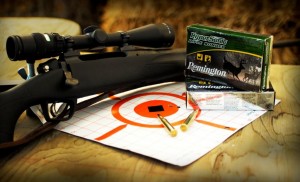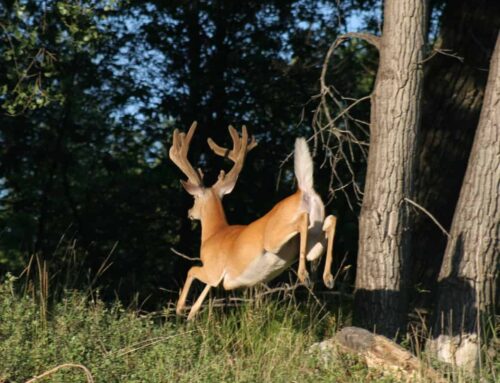 Right now is the perfect time to grab your hunting rifles and head to the shooting range. The joint will be empty this time of year, especially on weekdays. You can test different brands of ammo, sight-in a new scope or just practice with your old rigs without a crowd of shooters breathing down your neck for bench time like they would come September on the brink of another hunting season.
Right now is the perfect time to grab your hunting rifles and head to the shooting range. The joint will be empty this time of year, especially on weekdays. You can test different brands of ammo, sight-in a new scope or just practice with your old rigs without a crowd of shooters breathing down your neck for bench time like they would come September on the brink of another hunting season.
The more you fine-tune your rifles and shoot in the off-season, the better your chances of a one-shot game kill this fall. Here are 8 tips that will get you on zero and ready extra-early.
Easy Save-Money Sight-In
Rather than sighting-in the old way–firing a bunch of bullets at a target and cranking your scope until you finally walk the holes over to the bull’s-eye—try this. You can do it alone, but it works best with a buddy.
- Rest your rifle on sandbags on a solid bench. Crank your scope up to 9X or higher. Aim, lock on the bull’s-eye, load a round, take a deep breath and fire.
- Now don’t move the rifle/scope, regardless of where you hit. Keep it on the rest and eject the spent casing. Flip safety back on. Align scope on the bull’s-eye again (yes, again forget the first bullet hole for now). It is extremely important that you don’t move the rifle/scope from your original point of aim.
- Stay locked on the bull while a buddy, standing well behind the muzzle for safety, turns the scope’s knobs—first the vertical and then the horizontal—until the crosshairs move over and up or down and intersect your first bullet hole in the target, regardless of where it is.
- Once the crosshairs are aligned on the bullet hole, guess what–your rifle is zeroed! Load and fire a second and third shot to confirm it. The process takes only a few minutes saves you bullets and $$$.
Maximum Zero
Whether you shoot a .270, .30-06, 7mm Rem. Mag. or any cartridge really, sight-in to hit 2 to 2 ½ inches high at 100 yards. My dad taught me to do this 30 years ago, and I do it to this day. With most any modern hunting cartridge, a zero around 2 inches high at 100 will put you dead-on or thereabouts out to 250 yards. Most of the animals you shoot at will be inside 250, and you can push a shot out to 300 if you have to while still holding dead on the game’s shoulder. Hold on hair and take him.
Make a Cheat Sheet
If you hunt out West or around big fields or plains, prepare for long shots. After zeroing your rifle and load, type up a 1”x3” chart with bullet trajectory and wind drift (10 and 20 mph) at 200, 300 and 400 yards (if you’re comfortable shooting that far). Tape the chart to your rifle stock and check it before taking a long poke at a buck. Think this will make you look like a greenhorn? Forget it. Some of the best shooters and gunsmiths I know tape “cheat sheets” to their gunstocks.
Slug-Gun Ready
If you hunt in a slug-gun state or area, sight your shotgun and scope to hit about an inch high at 100 yards. Hold your shots at deer inside 130 yards or so and you’ll be perfect. Test several brands of 3-inch slugs in a 20-gauge; if you shoot a 12-gauge like most people, a 2 ¾” slug is fine and will put the hurt on a buck. You really don’t need a 12-gauge 3-inch slug and its extra recoil.
My theory is that if you are going to hunt with a primitive weapon, you might as well max it out. I love black-powder season and use the Remington Model 700 Ultimate Muzzleloader whever I go. Best load I’ve found is the standard one Remington recommends: 4 50-grain pellets of Triple 7 (200 grains total) and the Barnes Premier 250-grain copper bullet. I have shot hundreds of these loads at the range, and killed dozens of deer with these bullets. Accurate and deep-penetrating, with good exit holes and blood trails to follow. And the 200 grains produce much less recoil than you might imagine, due to the rifle’s weight, solid build and good fit.
With any muzzleloader, sight-in 2” or so high for shots at deer out to 150 yards or so (modern muzzleloaders can kill game out to 200 or even 300 yards, but 150 is my self-imposed max). Shoot a lot, even modern front-stuffers can be finicky.
Shoot 80-100 Practice Bullets
After sighting your guns, try to make at least one trip a month to the range from now until hunting season opens. Imagine how much better a shot you’ll be if you go to the range 8 or 10 times and shoot 10 rounds a trip, versus one or 2 range sessions and 5 to 10 practice shots like you’ve probably done in years past. No-brainer.
On your range trips, fire some shots from the bench out to 200 and 300 yards if you can. Then if your range allows it (or if you have a safe place to shoot in a pasture or plain) practice shots from kneeling, sitting and prone positions. Rest your gun on shooting sticks, go prone and rest on a pack or bipod, you get the idea. Simulate the shots you’re likely to get at a deer or elk this fall.
Trigger-Finger Workout
Lastly, here’s great practice you can do at home. Every once in a while, pull out your rifle and double-check and triple-check to make sure it’s unloaded. Shoulder it, aim in a totally safe direction, aim small at a distant rock or grass patch and dry-fire to become familiar with the trigger and it’s pull.
Okay, now that your guns and scopes, eye and trigger finger are finely tuned, drop that big 10-pointer or 6-point bull with one perfect shot when he shows up one day 8 or 9 months from now.







